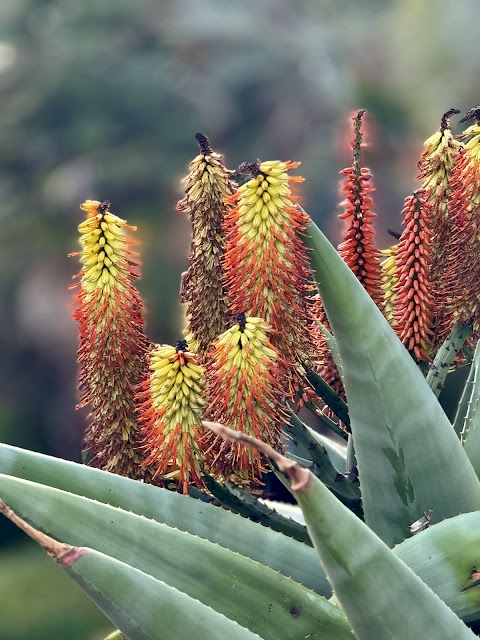 |
| With fine needles and leaves, the tough and sharp plants in the desert garden create a deceiving soft look. |
With over 130 acres, sixteen themed gardens and 83,000 living plants there are many reasons to visit the The Huntington Botanical Gardens. But for me it has always been for the stunning Desert Garden. I first visited the Huntington in the early 1990's and I've probably visited seven or eight times since then. Each visit I discover something new and by visiting at different times of the year you can see the various plant collections at their peak bloom. So, we scheduled an early February visit to Pasadena to check out the Huntington and other public gardens in the area. The main focus of the trip was to see the many winter blooming aloes in peak bloom. We had to cancel the first couple of days of the trip to avoid heavy rain and we had to return home in a hurry on the last day to escape one of the largest rain events in LA in years.
The Desert Garden
Today, The Huntington Library, Art Museum, and Botanical Gardens commonly is referred to simply as the "The Huntington". It all began back in 1903 when Henry E. Huntington (1850–1927) purchased the 600-acre working San Marino Ranch for growing crops, milk cows and poultry. In 1907 garden superintendent William Hertrich convinced Huntington to plant cacti on a half-acre of the property where nothing would grow. Between 1907 and 1908 Hertrich brought in plants from local nurseries, private residences, public parks, and from collection trips to the Southwest and Mexican deserts, building a collection which today includes over 2000 species covering 10 acres. The desert garden at over 100 years old is today the largest collection of cactus and succulents in the world. The garden is loosely divided between old world (Europe, Asia and Africa) succulents at the top of the garden and new world succulents (The Americas) at the bottom of the garden. This is largely because many of the plants in the lower garden can better tolerate the colder winter temperatures in that part of the garden.Here's a short video of our visit to the desert garden:
The Chinese Garden
We also visited several of the other gardens at the Huntington. The 15-acre Chinese Garden is named Liu Fang Yuan or the Garden of Flowing Fragrance and is one of the finest classical-style Chinese gardens outside of China. The garden is relatively new, only being added to the Huntington in the 2000s. Since then, several new areas have been built and landscaped to expand the garden. The garden is a collaboration between American landscape architects and designers and artisans in Suzhou, China. The visible materials used in the garden all originated in China, but underneath the materials are steel frames and concrete foundations built on site. The garden is built in the classical Ming Dynasty (1368–1644) style of private merchant and scholar gardens in Southeast China.
Here's a short video of our visit to the Chinese Garden:
Mosaic Pavings in the Chinese Garden
One of my favorite parts of the garden is the labor-intensive black and white pebble mosaics. If you've visited my garden, you may have noticed many mosaic pathways and landings. I sought inspiration for these from many locations, but none of mine are as geometrically perfect and detailed as the pavings in the Chinese Garden. These must have taken countless hours of backbreaking work to install.
Here's a short video of some of the pavings:
Japanese Garden
Like the desert garden, the Japanese Garden is one of the original gardens of the Huntington, dating back over 100 years. The original 1911 Japanese house was restored several years ago. More recently, and just opened, is the restored 300 year old Japanese Heritage Shōya House. The bonsai collection includes over 100 specimens showing the many styles of bonsai.
Here's a short video of our visit to the Japanese Garden:
We went to see the aloes in bloom but found so much more. Always great to visit the Huntington!

















Oh, so gorgeous! The shot of all those golden barrels always grab my attention, great timing that you got to see all the blooming aloes.
ReplyDelete